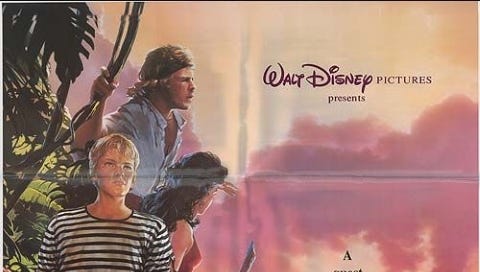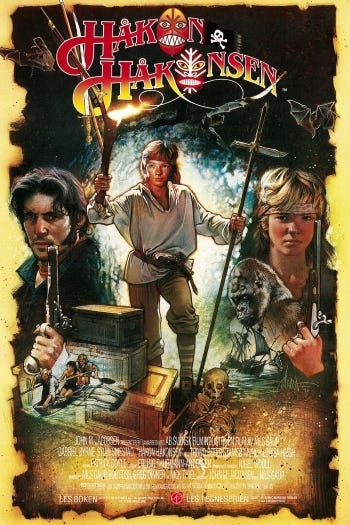When Disney released Shipwrecked in America in 1991, I was only tangentially aware of its existence. I worked in a video store at the time, so I knew about it but didn’t know what it was about. In the back of my mind, I assumed it was yet another Robert Louis Stevenson adaptation along the lines of Treasure Island and Kidnapped. Well, I was close but no cigar.
Turns out Robert Louis Stevenson never wrote a book called Shipwrecked. Instead, the film is based on the 1873 novel Haakon Haakonsen by O.V. Falck-Ytter, who was, in a way, the Robert Louis Stevenson of Norway, albeit not nearly as prolific or well-known. Falck-Ytter’s book was inspired by Dafoe’s Robinson Crusoe, a connection made explicit by the book’s subtitle En norsk Robinson (“A Norwegian Robinson”).
The film was the second effort from Sámi director Nils Gaup. For those who might not know, the Sámi, also referred to derisively as Laplanders, are the Indigenous peoples of Northern Scandinavia. Gaup himself is from Norway. He’d made an impressive debut in 1987 with Pathfinder, a harsh and often violent adventure set in the year 1000 following a young man whose family is slaughtered by a nomadic band of black-clad invaders. The movie earned an Academy Award nomination for Best Foreign Language Film and was remade (more or less, mostly less) in 2007.
After the worldwide success of Pathfinder, Gaup wanted to tackle Haakon Haakonsen, a beloved childhood classic in Norway. But this was going to be an even more ambitious undertaking, requiring locations around the world, period sets and costumes and, as you may have surmised, a full-scale shipwreck. Gaup’s Norwegian producers would need an international partner to pull it off. Carolco, Pathfinder’s American distributor, was either unable or unwilling to put up the money itself. But they did help make introductions and shopped Gaup’s first film and new script around Hollywood.
When Disney expressed interest, Gaup and producer John M. Jacobsen knew it was the right fit. They wanted to make a movie squarely in the tradition of Disney’s boy’s adventure pictures like Treasure Island. The studio had a few suggestions, assigning Nick Thiel, who had recently worked on the screenplay for White Fang, to do some work on the script by Gaup, Bob Foss and Greg Dinner. But overall, Disney seemed content to sit back and let Gaup make his movie. After all, they were only co-financing the picture, so it wasn’t as if they had a lot to lose.
The movie stars Stian Smestad (who doesn’t appear to have any other acting credits…he later studied film and became a director of commercials and music videos) as Haakon, a very blond, very blue-eyed Norwegian farm boy. Haakon’s sailor father returns home after an extended journey with his leg badly injured, unable to return to the sea. With the family about to lose everything to the bank, Haakon steps up to accept a commission as ship’s boy on his father’s old ship.
Haakon is arguably too young and soft for such a position and it takes him some time to learn the ropes (no pun intended). But under the tutelage of a more experienced sailor named Jens (Trond Peter Stamsø Munch) and the stern but fair and respected Captain (Kjell Stormoen), he’s earned his place among the men by the time they reach London.
Because their journey now takes them through the South Seas and into pirate territory, the Captain brings aboard a British naval officer named Lt. John Merrick (presumably no relation to the Elephant Man and played by Gabriel Byrne, the only internationally recognizable star in the film). But unbeknownst to the crew, Merrick is actually a notorious pirate who has taken the identity of the officer. He supplements the crew with his own men, poisons the captain and takes command of the ship.
Haakon is immediately suspicious of Merrick when he discovers several crate loads of rifles below deck and the captain’s death only confirms his ill feelings. But he attempts to lie low after he discovers Mary (Louisa Haigh), a stowaway orphan trying to reach her uncle in Calcutta. Eventually, Mary is discovered and just as Merrick is about to punish Haakon with a cat-o-nine-tails for harboring a stowaway, a massive storm hits and the crew is forced to abandon ship.
Separated from the others, Haakon wakes up on a deserted island. After some exploration, he discovers Merrick’s treasure along with proof of his real identity. Sure that Merrick will eventually turn up looking for his loot, Haakon conceals it and rigs the island with a series of booby traps.
Eventually, he spots another island off on the horizon. After some trial and error, Haakon builds a small boat to carry him over. Here, he is reunited with Jens and Mary, who were rescued by a peaceful and friendly tribe of natives. Haakon fills them in on his discoveries and the little group returns to Treasure Island just in time to meet up with Merrick and his band of cutthroats.
Disney released several films in the 1980s and ‘90s that wouldn’t have been out of place decades earlier. Animal pictures like Benji The Hunted and gimmick comedies like Honey, I Shrunk The Kids served up familiar genres with a modern twist. Shipwrecked is the first that would have actually benefited from being released in the 1950s. The film immediately hearkens back to the Disney adventure films of old with a swelling, old-fashioned score by Patrick Doyle and a prologue set in a backlot rendition of 19th Century London. It then proceeds to take its time before getting to the titular shipwreck, setting a leisurely pace that was falling out of fashion by 1991.
Some of that old-fashioned feeling works against the picture. The dialogue is a little stilted, hardly surprising considering the movie was dubbed to allow for both Norwegian and English versions. The movie just barely has enough action in it to justify its PG rating. And Haakon’s island adventures include an encounter with a guy in a gorilla suit so goofy, he’d might just as well be wearing a trenchcoat and smoking a stogie.
However, Gaup does update the formula where it matters. The shipwreck sequence itself is exciting and handsomely mounted. The brief sequence with the natives, which undoubtedly would have been a masterclass in racism back in the day, undercuts expectations in a refreshing and amusing way. And, perhaps most importantly, Haakon himself isn’t presented as an exceptionally gifted superboy. His maturation is, if not necessarily realistic, at least believable. He makes mistakes, he learns from them, then makes different mistakes.
That really comes across in the finale where it’s revealed that a lot of those booby traps Haakon so carefully set don’t actually work in practice. Most critics, including legendary Disney fan Leonard Maltin, inevitably compared those traps to Home Alone, which would have been fresh in everyone’s memory at the time. But the real antecedent is Disney’s Swiss Family Robinson. Here again, Gaup plays with the trope by having traps fail or ensnare the wrong people.
Shipwrecked was released in Norway under its original title on October 3, 1990. Disney launched it in America on March 1, 1991. A handful of critics, including Maltin, enjoyed it for what it was but most found it hokey. US audiences appeared to agree. It opened in seventh place, well behind adult-oriented hits like The Silence Of The Lambs and even Home Alone, which was still hanging in there despite the fact that Christmas was a distant memory. It performed better in its homeland, which helped it turn a small profit, but here in the States, it ended up with around $15 million.
In the end, Shipwrecked probably is a little too old-fashioned for its own good. Its key demographic, 13-year-olds around Haakon’s age, had moved past pirates, unless they were in outer space. But for fans of Disney’s Treasure Island, there’s enough here to recommend. It’s a fun, easy-going throwback to the kinds of movies they really don’t make anymore.
VERDICT: It’s a minor Disney Plus.







I saw this in the theaters as a nine-year-old and loved every minute of it. Still come back to it if I’m feeling nostalgic, and can’t wait to show it to my own kid when he’s old enough.
I think what I liked about it most was the fact that in this movie, unlike “treasure island” or “Swiss family Robinson”, the kid is the one driving the action. In the others, the children -even Jim Hawkins- feel like they’re a bit more just “along for the ride”.
I liked watching those other adventures, but I wanted to BE Hakkon.